American DC-3 Flagship
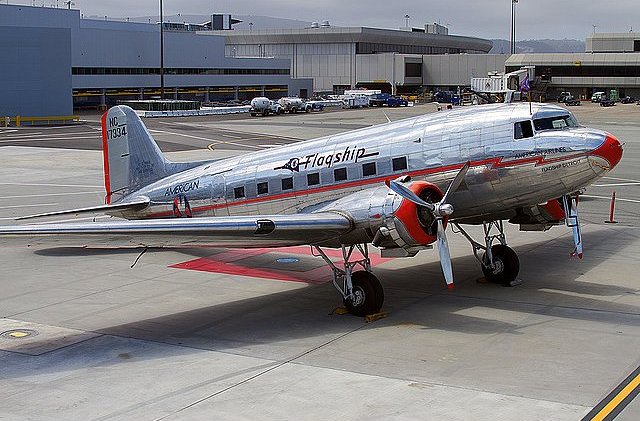
Three, Gooney Bird, Doug, Dakota, Douglas Racer - no matter what it's called , one can legitimately argue that the most influential airplane on commercial aviation was the Douglas DC-3. It was the first airliner with operating costs low enough to allow a profit in all passenger service (previously , a contract to carrythe mail was essential to make a money on any route). Flown bu virtually every airline in the world, it's combination of power, payload, speed and ability to operate from almost any surface (they were also put on skis and floats) meant that for nearly two decades the DC-3 was the ubiquitous airliner; after became the ubiquitous freighter. Even now, with lower operationg costs of turbines taking over the freight business, there are still DC-3's working for a living throughout the world. It was one of the airplanes where the design proved to be precisely right.
American Airlines was the largest user, buying some 114 DC-3s and DSTs (a briefly built sleeper version, which had berths that converted to beds - the DSTs had a set of narrow windows for the upper berths, above the main cabin windows). That it was the largest airline user of the DC-3 may have also been because American's president C.R Smith was the driving force in convincing a reluctant Donald Douglas, chief of Dougas Aircraft, to build the DC-3 when Douglas was coining money producing the DC-2. The first DC-3 flew on December 17, 1935, the 32nd aniversary of the Wright Brothers' first flight. The oldest one still flying, the Flagship detroit, became a flagship when it was delivered to American 15 months later, beginning a decade of service with the airline.
A Flagship
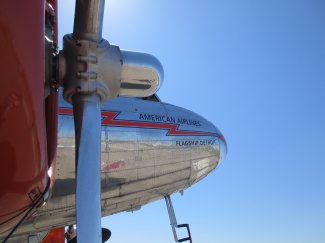 All America airliners were flagships. They heralded their presence on an airport by the copilot opening his cockpit window and inserting a flafstaff bearing an American Airlines flag into a socket just outside the window immediatly after landing. The arrival or departure of an America airliner was never to be a humdrum event - it took place with flag flying. And woe to the copilot who forgot to insert the flag after landing; or worse yet, to remove it before takeoff.
All America airliners were flagships. They heralded their presence on an airport by the copilot opening his cockpit window and inserting a flafstaff bearing an American Airlines flag into a socket just outside the window immediatly after landing. The arrival or departure of an America airliner was never to be a humdrum event - it took place with flag flying. And woe to the copilot who forgot to insert the flag after landing; or worse yet, to remove it before takeoff.
As is the case with most DC-3s, the Flagship Detroit's subsequent history was a journey through many opf the aeronautical uses to which a former airliner may be put and descent int more fanancially perilous end of the commercial aviation spectrum - wher maintenance is a sometime thing and the true risk the airplane faces is either being cut up for beer cans or flown into a mountainside by a crew so hungary it made the flight against its better weather judgment.
By 2004, the airplane that had once provided luxury service to American Airlines customers had tanks of insecticide in its cabin, spray booms behind its wings and was being used as an aerial applicator in a local war against mosquitoes.
It was located and purchasd by the Flagship Detroit Foundation, formed byformer and current Amerikcan Airlines employeesdetermined to find and restore the oldest former American Airlines DC-3 it could. After years of work, the Flagship Detroit again wears American Airlines' livery, down to the socket for the flagstaff adjacent to the copilot's window.
 Its p;olished aluminum exterior utterly gleaming , the Flagship Detroit now travels around the country to airshows, giving vistiors an opportunity to see how air travel was 75 years ago, when a New York (Newark, really) - LosAngeles round trip ticket sold for $4,500 in today's dolars. Flown mostly by retired American Airlines pilots (most of whom never flew an airplane with a propeller on it during their airline careers but flew its military version, the C-47, as freighters before getting an airline job), the Flagship Detroit is lovingly maintained by volunteers.
Its p;olished aluminum exterior utterly gleaming , the Flagship Detroit now travels around the country to airshows, giving vistiors an opportunity to see how air travel was 75 years ago, when a New York (Newark, really) - LosAngeles round trip ticket sold for $4,500 in today's dolars. Flown mostly by retired American Airlines pilots (most of whom never flew an airplane with a propeller on it during their airline careers but flew its military version, the C-47, as freighters before getting an airline job), the Flagship Detroit is lovingly maintained by volunteers.
The interior reflects the "two and one" seating of DC-3s of the era, two seats on one side of the isle, one seat on the other. Designer s selected the colors for all parts of the interior with concern for comfort of the passengers at the top of the list. They knew that a huge portion of the passengers were frighteded at the idea of making a flight, so the colors to be as reassuring as possible - as well as selected to avoid creating nausea. There are no greens in the cabin.
Right Side Door
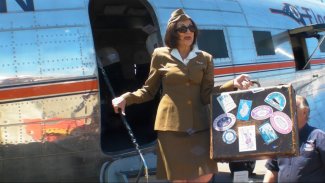 The entry door is on the right side of the airplane, specified by American Airlines' president C.R. Smith for reasons said to range from keeping the airplane consistent with terminal facilities that had been set up for the Foker and Ford Trimotors and the Curtiss Condors - in some cases the airplanes taxied into large hangars for loading and unloading - to Smith not wanting his wealthy passengers to see baggage smashers loading and unloading their expensive luggage through the relatively small baggage door on the left side of the fuselage. Nevertheless, seeing a DC-3 that does not have a large double cargo door (standard on the C-47 and a frequent conversion on DC-3s) is rare enough - seeing one with a passenger door on the right means the odds are good it was one of American Airlines' earliest DC-3s.
The entry door is on the right side of the airplane, specified by American Airlines' president C.R. Smith for reasons said to range from keeping the airplane consistent with terminal facilities that had been set up for the Foker and Ford Trimotors and the Curtiss Condors - in some cases the airplanes taxied into large hangars for loading and unloading - to Smith not wanting his wealthy passengers to see baggage smashers loading and unloading their expensive luggage through the relatively small baggage door on the left side of the fuselage. Nevertheless, seeing a DC-3 that does not have a large double cargo door (standard on the C-47 and a frequent conversion on DC-3s) is rare enough - seeing one with a passenger door on the right means the odds are good it was one of American Airlines' earliest DC-3s.
In a concession to reality, the panel has curent instruments rather than the primitive blind-flying panel installed at the factory. While thousnads of pilots flew IFR behind those panels, not all of the attempts were successfull - and this airplane is intended to fly for many years to come.
The crew seats put the pilots' noses almost against the windshield, a feature that surprises most modern pilots, but also makes for startlingly good visibility from behind a relatively small amount of glass - and alows practicing IFR ops by the astonishingly simple expedient of putting a strip of cardboard about four inches against the bottom portion of the pilot's windshield.
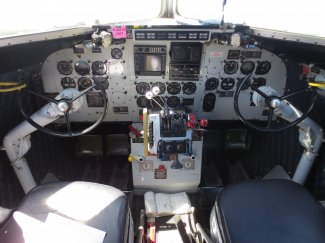 Much of the cockpit is restored to how it would have looked when the airplane rolled out of the Douglas Santa Monica factory - not plush, a place where professionals worked. It was definately a two-pilot airplane - some of the controls, such as the cowl flaps, are placed where only the co-pilot can reach them. The landing gear levers (there are two of them - and you have to operate them in a complicated sequence, correctly, or risk jamming the gear partially extended) are on the floor next to the left side of the co-pilot's seat.
Much of the cockpit is restored to how it would have looked when the airplane rolled out of the Douglas Santa Monica factory - not plush, a place where professionals worked. It was definately a two-pilot airplane - some of the controls, such as the cowl flaps, are placed where only the co-pilot can reach them. The landing gear levers (there are two of them - and you have to operate them in a complicated sequence, correctly, or risk jamming the gear partially extended) are on the floor next to the left side of the co-pilot's seat.
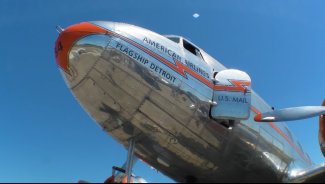 The baggage compart-
The baggage compart-
ment between the cockpit and cabin is there, big as life, as is its access door - the hamburger door. That name came from hard experience; the door opens only inches from the left prop.
Wright Engines
Although most DC-3s wound up with Pratt and Whitney engines, the Flagship Detropit has Wright Cyclones - as is did when it was built, only now they put out more power. In 1937 the Cyclone developed 1,000 HP; over the years that went up. The current engines can develop 1,350 HP, but the Foundation has decided to limit thtm to 1,200 HP in operation. At $45,000 per side, that makes dense. Unlike modern opposed replica breitling aircraft engines which are designed to be run at full power for extended periods of time and can be damaged by partial-power takoffs, the life of a radial can be increrased by decreasing the maximum power called for on takeoff.
General characteristics
Crew: Two
Capacity: 21 - 32 passengers
Length: 64 ft 8 in
Wingspan: 95 ft 2 in
Height: 16 ft 11 in
Empty weight: 16,865 lbs
Max gross weight: 25,199 lbs
Fuel capacity: 822 gal
Engines:
Wright Cyclone R-1820, 1,100 hp
Pratt&Whitney R-1830 Wasp, 1,200 hp
Performance
Maximum speed: 200 kts (230 mph)
Cruise speed: 180 kts (207 mph)
Stall speed: 58.2 kts (67 mph)
Service ceiling: 23,200 ft
Rate of climb: 1,130 fpm
|
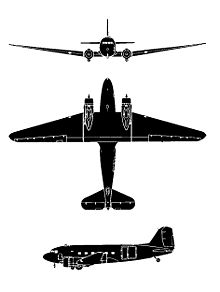 |
 |
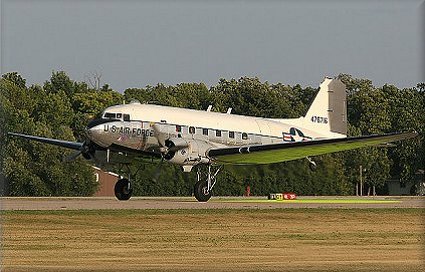
|

|
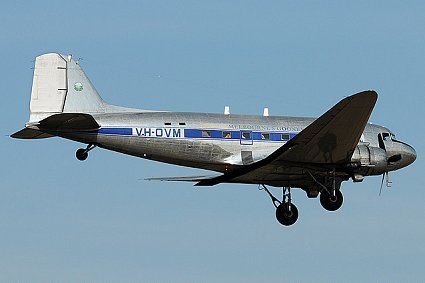 This particular aircraft was delivered to the USAAF on April 21, 1945 with the serial number 44-76770. Seventy-one years ago! Transferred to the RAAF under the 'lend lease' agreement as A65-98 and operated extensively from Butterworth, Malaysia between 1964 and 1975. After some time at Wagga Wagga and the RAAF Museum at Point Cook it was entered onto the Civil Register on July 3, 1989 as VH-JXD. Eventually sold to Shortstop Aviation and reregistered as VH-OVM on June 2, 1990. The question is, "How long can these airplanes be kept flying?" This particular aircraft was delivered to the USAAF on April 21, 1945 with the serial number 44-76770. Seventy-one years ago! Transferred to the RAAF under the 'lend lease' agreement as A65-98 and operated extensively from Butterworth, Malaysia between 1964 and 1975. After some time at Wagga Wagga and the RAAF Museum at Point Cook it was entered onto the Civil Register on July 3, 1989 as VH-JXD. Eventually sold to Shortstop Aviation and reregistered as VH-OVM on June 2, 1990. The question is, "How long can these airplanes be kept flying?" |
This is a copy of an article from AvWeb, by Rick Durden, Features/News Editor at AvWeb
Check out Dick Durdens´ book, The Thinking Pilot´s Flight Manual Or, How to Survive Flying Little Airplanes and Have a Ball Doing It, Vol. I.
 Its p;olished aluminum exterior utterly gleaming , the Flagship Detroit now travels around the country to airshows, giving vistiors an opportunity to see how air travel was 75 years ago, when a New York (Newark, really) - LosAngeles round trip ticket sold for $4,500 in today's dolars. Flown mostly by retired American Airlines pilots (most of whom never flew an airplane with a propeller on it during their airline careers but flew its military version, the C-47, as freighters before getting an airline job), the Flagship Detroit is lovingly maintained by volunteers.
Its p;olished aluminum exterior utterly gleaming , the Flagship Detroit now travels around the country to airshows, giving vistiors an opportunity to see how air travel was 75 years ago, when a New York (Newark, really) - LosAngeles round trip ticket sold for $4,500 in today's dolars. Flown mostly by retired American Airlines pilots (most of whom never flew an airplane with a propeller on it during their airline careers but flew its military version, the C-47, as freighters before getting an airline job), the Flagship Detroit is lovingly maintained by volunteers.
 All America airliners were flagships. They heralded their presence on an airport by the copilot opening his cockpit window and inserting a flafstaff bearing an American Airlines flag into a socket just outside the window immediatly after landing. The arrival or departure of an America airliner was never to be a humdrum event - it took place with flag flying. And woe to the copilot who forgot to insert the flag after landing; or worse yet, to remove it before takeoff.
All America airliners were flagships. They heralded their presence on an airport by the copilot opening his cockpit window and inserting a flafstaff bearing an American Airlines flag into a socket just outside the window immediatly after landing. The arrival or departure of an America airliner was never to be a humdrum event - it took place with flag flying. And woe to the copilot who forgot to insert the flag after landing; or worse yet, to remove it before takeoff. The entry door is on the right side of the airplane, specified by American Airlines' president C.R. Smith for reasons said to range from keeping the airplane consistent with terminal facilities that had been set up for the Foker and Ford Trimotors and the Curtiss Condors - in some cases the airplanes taxied into large hangars for loading and unloading - to Smith not wanting his wealthy passengers to see baggage smashers loading and unloading their expensive luggage through the relatively small baggage door on the left side of the fuselage. Nevertheless, seeing a DC-3 that does not have a large double cargo door (standard on the C-47 and a frequent conversion on DC-3s) is rare enough - seeing one with a passenger door on the right means the odds are good it was one of American Airlines' earliest DC-3s.
The entry door is on the right side of the airplane, specified by American Airlines' president C.R. Smith for reasons said to range from keeping the airplane consistent with terminal facilities that had been set up for the Foker and Ford Trimotors and the Curtiss Condors - in some cases the airplanes taxied into large hangars for loading and unloading - to Smith not wanting his wealthy passengers to see baggage smashers loading and unloading their expensive luggage through the relatively small baggage door on the left side of the fuselage. Nevertheless, seeing a DC-3 that does not have a large double cargo door (standard on the C-47 and a frequent conversion on DC-3s) is rare enough - seeing one with a passenger door on the right means the odds are good it was one of American Airlines' earliest DC-3s. Much of the cockpit is restored to how it would have looked when the airplane rolled out of the Douglas Santa Monica factory - not plush, a place where professionals worked. It was definately a two-pilot airplane - some of the controls, such as the cowl flaps, are placed where only the co-pilot can reach them. The landing gear levers (there are two of them - and you have to operate them in a complicated sequence, correctly, or risk jamming the gear partially extended) are on the floor next to the left side of the co-pilot's seat.
Much of the cockpit is restored to how it would have looked when the airplane rolled out of the Douglas Santa Monica factory - not plush, a place where professionals worked. It was definately a two-pilot airplane - some of the controls, such as the cowl flaps, are placed where only the co-pilot can reach them. The landing gear levers (there are two of them - and you have to operate them in a complicated sequence, correctly, or risk jamming the gear partially extended) are on the floor next to the left side of the co-pilot's seat. The baggage compart-
The baggage compart-



 This particular aircraft was delivered to the USAAF on April 21, 1945 with the serial number 44-76770. Seventy-one years ago! Transferred to the RAAF under the 'lend lease' agreement as A65-98 and operated extensively from Butterworth, Malaysia between 1964 and 1975. After some time at Wagga Wagga and the RAAF Museum at Point Cook it was entered onto the Civil Register on July 3, 1989 as VH-JXD. Eventually sold to Shortstop Aviation and reregistered as VH-OVM on June 2, 1990. The question is, "How long can these airplanes be kept flying?"
This particular aircraft was delivered to the USAAF on April 21, 1945 with the serial number 44-76770. Seventy-one years ago! Transferred to the RAAF under the 'lend lease' agreement as A65-98 and operated extensively from Butterworth, Malaysia between 1964 and 1975. After some time at Wagga Wagga and the RAAF Museum at Point Cook it was entered onto the Civil Register on July 3, 1989 as VH-JXD. Eventually sold to Shortstop Aviation and reregistered as VH-OVM on June 2, 1990. The question is, "How long can these airplanes be kept flying?"